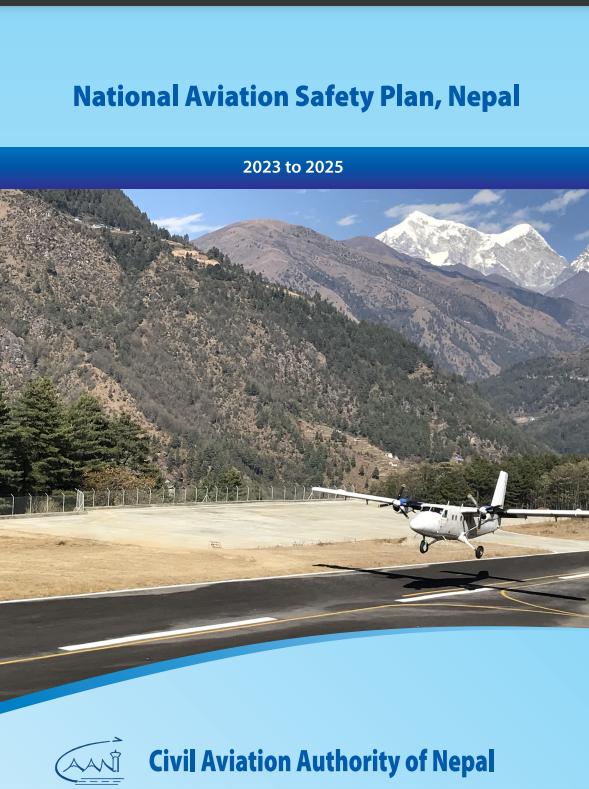
Remotely Piloted Aircraft Regulations in Nepal
Remotely Piloted Aircraft (RPA), also known as Unmanned Aerial Vehicles (UAVs) or drones, though not new to the world aviation, is still one of the areas being explored in terms of technical advancement and regulation of its operation. RPAS involves the operation of an aircraft without a pilot inside it. Annex 2 to the Convention on International Civil Aviation, Rules of the Air, defines Remotely Piloted Aircraft as an unmanned aircraft which is piloted from a remote pilot station. Similarly, Annex 2 defines Remotely Piloted Aircraft System as a remotely piloted aircraft, its associated remote pilot station (s), the required command and control links and any other components as specified in the type design.
Drones have gained immense popularity across the world due to their various applications in different sectors. Though drones were being used by various military organizations for over a decade, the application related to drones had never been so widespread in civil aviation sector. Use of drone in commercial and recreational capacity has widened its scope in recent years. Nepal, being a nation with diverse landscape and potential use cases, has also witnessed upsurge in drone usage.
Uses of drones in Nepal
Drones are being used for various purposes in Nepal and may be registered and operated by an individual or an organization. No exclusive drone operator has been registered in Nepal so far. However, the market for drones is expanding rapidly as new applications are emerging to incorporate the use of civilian drones in our daily lives. With the proliferate use of drones in general, and emergence of drones for various uses having not been fathomed until a few decades back, exclusive drone operators are anticipated to be registered and brought into operations pretty soon.
As of today, most of the drone operations in Nepal are found to be confined to individual hobbies, amateur photography and videography. However, drones are also being used for specific purposes such as aviation wind hazard mapping in the suburbs of prominent cities of Kathmandu and Pokhara, aerial surveys by the Department of Survey, transmission line bay extension in the major hydropower projects, biomass and invasive species mapping, transportation of samples for COVID tests in remote areas of western Nepal during the COVID-19 pandemic, aerial surveillance during disasters such as floods, landslides and earthquakes, search and rescue in high altitude, GIS mapping, transporting medical supplies in remote areas and wildlife conservation purposes etc.
In the upcoming days, the use of drones is expected to spread into activities such as product delivery, resource investigation, enforcement etc., ensuring its broader use in development.
ICAO standards and national regulatory framework
As guided by the Chicago Convention Article 8, “no aircraft capable of being flown without a pilot shall be flown without a pilot over the territory of a contracting State without special authorization by that State and in accordance with the terms of such authorization. Each contracting State undertakes to insure that the flight of such aircraft without a pilot in regions open to civil aircraft shall be so controlled as to obviate danger to civil aircraft.”
Therefore, an unmanned aerial vehicle shall be subject to the provision of article 8 of the Chicago Convention for special authorization.
Annex 2, Section 3.1.9 mandates that an RPA shall be operated in such a manner as to minimize hazards to persons, property or other aircraft and in accordance with the conditions specified in Appendix 4.
These articles and SARPs mandate us to ensure safety of persons, property and all aircraft from the potential hazards associated with RPAS or drone operations. Thus, the main purpose of RPAS regulations is to address the protection of society from mid-air collisions (MACs) with aircraft and crashes. In accordance to the Civil Aviation Act, 2053, Section 5, the Director General of CAAN is responsible to adopt and implement the ICAO SARPs in Nepal. Thus, the safety of aircraft operations, together with drone operations, remain the prime responsibility of the Civil Aviation Authority of Nepal.
To fulfil this obligation, the efforts of streamlining drone operations within regulatory framework started almost a decade back when sparse cases of drone operations started being noticed. Safety concerns started being raised because of a couple of cases of drone operations near airport areas in 2015. Prior to that, the ANC of ICAO, at its 196th Session held on May 2014, had agreed to the establishment of RPA Systems Panel (RPASP) for the purpose of, inter alia, serving as focal point for all ICAO RPAS related work, developing RPAS regulatory concept along with guidance material and developing further SARPs related to RPAS. In these pretexts, Nepal felt the need of development of drone related provisions for streamlining such operations. Hence, Civil Aviation Authority of Nepal issued a directive “Flight Operation Directive No- 7, May 2015” aiming to address the safety issues related to its operation by informing the operators not to conduct RPAS operation in specified areas especially the areas having potential of posing risk to the safety of existing air transport system.
The Directive had been issued in the pretext of safety concerns emerging from operations of unmanned vehicles, with CAAN having no surveillance system equipped with its existing system meant for safety of commercial air transportation. Taking into consideration the fact that the operation of drones involve higher security and privacy concerns, Ministry of Home Affairs had been involved in the matter at that time. Hence, in coordination with the Civil Aviation Authority of Nepal, “Procedure related to RPAS/Drone” in 2019 was issued by the Ministry of Home Affairs as an effort to facilitate the use of drones ensuring security of people at large, together with ushering the drone operations into a regulatory framework and guidance. As a result, the “Flight Operation Directive No- 7, May 2015” was superseded by the “CAAN Unmanned Aerial System Requirements” issued in 2021 which was promulgated in consonance with the “Procedure related to RPAS/Drone” in 2019 issued by the Ministry of Home Affairs.
According to these procedures, the authority of granting permission to the drone operations in Nepal lies with the Ministry of Home Affairs wherein such authority, as delegated by the MoHA, is also exercised by the District Administration Office. In case if the operation area is within the radius of 5 Km from any airport, the permission from concerned Civil Aviation Office is also required.
The responsibility of registering the drones lies with the Civil Aviation Authority of Nepal. The Unique Identification Number (UIN) issued by CAAN is labelled in the device itself before commencing procedure for a particular drone operation.
Some regulatory provisions of the procedures related to drone operations in Nepal
The development of effective safety regulations for unmanned aircraft systems (UAS) is an issue of paramount concern for industry. Such framework is a prerequisite for greater UAS access to civil airspace and, subsequently, the continued growth of the UAS industry. The drone requirements set forth in the directives issued by the CAAN and MoHA include a set of general operating rules within which registered drones can operate. Even though these rules have been framed within many legislative as well as technical limitations, they serve as the foundation of safety efforts related to drone operations in Nepal. Some of these rules have been discussed here under.
The procedure has classified the RPAs into four categories based on the maximum takeoff weight (MTOW), namely category A (very low risk operations) which includes drones of MTOW 250 gm or less, category B (low risk operations) which includes drones of MTOW ranging from 250 gm to 2 Kg, category C (regulated, low risk operations) which includes drones of MTOW of more than 2 kg up to 25 kg, and category D (regulated, high risk operations) which includes drones of MTOW of more than 25 kg.
Based on the sensitivity of area with regards to safety, the area of drone operations has been classified into general, medium and sensitive.
For ensuring aviation safety, all drone operations are required to be conducted under conditions of 5 km or more visibility, 450 m or more ceiling, surface wind conditions 10 knots or less, no rain, thunderstorm, lightening, snow or hailstorm. Pilot is required to have the basic knowledge of the area of flight and its religious, historical, archaeological importance, if any. The pilot needs to maintain visual line of sight during drone operations.
Range from the pilot for UAV operations has been limited to 300 m horizontally and 100 m vertically and 30 m from third person and specified endurance of RPA has been limited to 15 min.
Considering the security aspects of UAV operations, a couple of provisions have been laid down. Security personnel need to be present during special circumstances such as operation related to disaster management. Similarly, carriage of dangerous goods, biological weapons, animals and humans is strictly prohibited during drone operations. Further, there is requirement for third party insurance in case of category C and D operations.
Drone Regulations: challenges and prospects
The existing state of drone regulations is not that encouraging since no oversight mechanism as regards to, inter alia, operations, airworthiness, personnel licensing have so far been established. Current requirement/directive in use is an endeavor to streamline different types of drone operations in Nepal and ensure safety of their operations together with the commercial air transportation in Nepal. Implementing even the existing provisions is not sans challenges. The main challenge lies in the fact that the permission is being granted by the MoHA, rather than an aeronautical authority. Therefore, the regulation of drone activities in Nepal has become an uphill task.
Challenges also lie in the areas of airspace integration and traffic management including geo fencing and establishing no fly zones, remote ID and tracking, real time communication and data sharing, advanced detect and avoid system, collaboration between efforts of government and industry, etc.
In order to cope up with all the present challenges and to incorporate drone operations under the same umbrella of safety management, CAAN needs to establish comprehensive and scalable system for managing drones along with other manned aircraft. Further, there is an utmost need to adopt the technologies that can be applied to create virtual boundaries and no fly zones around sensitive areas such as airports and restricted areas. Similarly, real time communication and data sharing between drones and air traffic management systems need to be enabled so that dynamic adjustments to flight paths would be allowed helping mitigate potential conflicts with manned aircraft. Integrating drones into existing air traffic control infrastructure as far as possible could also help ease the issuance of clearance and mechanism of coordination. CAAN should also give due consideration to invest in research and development of advanced detect and avoid system of drones using radar, lidar and other sensors to detect and avoid collisions with other aircraft.
The surveillance woes associated with the upsurge of drone operations and scope of applicability can be assuaged by permitting import from certified vendors only, implementing requirements related to pre-import approvals from concerned entities such as Defense and Telecom, certification of operators, establishing licensing and oversight requirements, recruitment and retention of appropriate human resources, focusing on training needs and public awareness etc.
Drone Regulations: pacing up with ICAO
National Aviation Safety Plan, Nepal (2023-2025) prepared in congruence with the ICAO Global Aviation Safety Plan and Regional Aviation Safety Plan (APAC), recognizes Unmanned Aerial Vehicle (UAV) or drones operating in the vicinity of aerodromes as emerging safety risk in context of Nepal. However, No Safety Enhancement Initiatives (SEIs) and Action Plans for the reduction of safety risks have been identified by the plan. Requiring drone operators to implement Safety Management System (SMS) based on the size, nature and complexity of the organization, as proposed by ICAO in its proposal for the amendment of Annex 19, Safety Management could help Nepal move along its path of safer sky.
In the context of emergence of new proposals from ICAO for the amendment of SARPs related to drones envisaging a condition of inclusion of drone operations within the scope of aviation safety and security, the present situation of drone regulations in Nepal may not prevail that long.
With these regulatory requirements in place, Nepal has a broader plan to address the safety issues emanating from drone operations and is also in the process of adopting the SARPs as proposed by ICAO through the amendment of its Annexes, especially Annex 1, Annex 2, Annex 6, Annex 8, Annex 13 and Annex 19.
By Ritcha Sharma
Vice Chair - ENAC Alumni Nepal and Bhutan Chapter
References:
Chicago Convention, Doc. 7300
ICAO Annex 2- Rules of the Air
ICAO State Letters: Proposals for the amendment of various Annexes
National Aviation Safety Plan, Nepal (2023-2025)
“Remotely Piloted Aircraft (PRA)/Drone Procedure” 2072 B.S. MoHA, Government of Nepal
CAAN Unmanned Aircraft System (UAS) Requirements, April 2021














No comment
Log in to post comment. Log in.